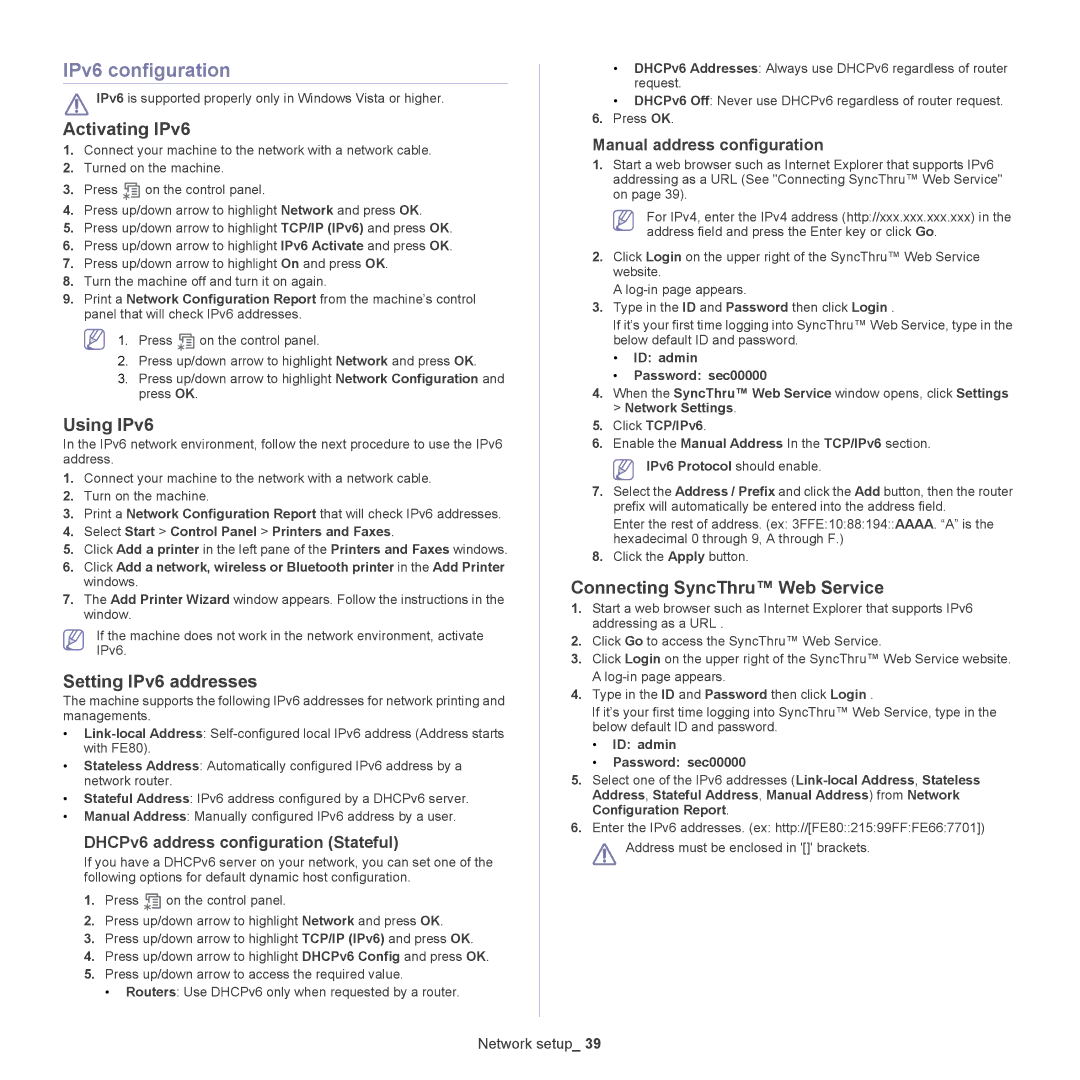
IPv6 configuration
IPv6 is supported properly only in Windows Vista or higher.
Activating IPv6
1.Connect your machine to the network with a network cable.
2.Turned on the machine.
3.Press ![]() on the control panel.
on the control panel.
4.Press up/down arrow to highlight Network and press OK.
5.Press up/down arrow to highlight TCP/IP (IPv6) and press OK.
6.Press up/down arrow to highlight IPv6 Activate and press OK.
7.Press up/down arrow to highlight On and press OK.
8.Turn the machine off and turn it on again.
9.Print a Network Configuration Report from the machine’s control panel that will check IPv6 addresses.
1. Press ![]() on the control panel.
on the control panel.
2.Press up/down arrow to highlight Network and press OK.
3.Press up/down arrow to highlight Network Configuration and press OK.
Using IPv6
In the IPv6 network environment, follow the next procedure to use the IPv6 address.
1.Connect your machine to the network with a network cable.
2.Turn on the machine.
3.Print a Network Configuration Report that will check IPv6 addresses.
4.Select Start > Control Panel > Printers and Faxes.
5.Click Add a printer in the left pane of the Printers and Faxes windows.
6.Click Add a network, wireless or Bluetooth printer in the Add Printer windows.
7.The Add Printer Wizard window appears. Follow the instructions in the window.
If the machine does not work in the network environment, activate IPv6.
Setting IPv6 addresses
The machine supports the following IPv6 addresses for network printing and managements.
•
•Stateless Address: Automatically configured IPv6 address by a network router.
•Stateful Address: IPv6 address configured by a DHCPv6 server.
•Manual Address: Manually configured IPv6 address by a user.
DHCPv6 address configuration (Stateful)
If you have a DHCPv6 server on your network, you can set one of the following options for default dynamic host configuration.
1.Press ![]() on the control panel.
on the control panel.
2.Press up/down arrow to highlight Network and press OK.
3.Press up/down arrow to highlight TCP/IP (IPv6) and press OK.
4.Press up/down arrow to highlight DHCPv6 Config and press OK.
5.Press up/down arrow to access the required value.
• Routers: Use DHCPv6 only when requested by a router.
•DHCPv6 Addresses: Always use DHCPv6 regardless of router request.
•DHCPv6 Off: Never use DHCPv6 regardless of router request.
6.Press OK.
Manual address configuration
1.Start a web browser such as Internet Explorer that supports IPv6 addressing as a URL (See "Connecting SyncThru™ Web Service" on page 39).
For IPv4, enter the IPv4 address (http://xxx.xxx.xxx.xxx) in the address field and press the Enter key or click Go.
2.Click Login on the upper right of the SyncThru™ Web Service website.
A
3.Type in the ID and Password then click Login .
If it’s your first time logging into SyncThru™ Web Service, type in the below default ID and password.
•ID: admin
•Password: sec00000
4.When the SyncThru™ Web Service window opens, click Settings > Network Settings.
5.Click TCP/IPv6.
6.Enable the Manual Address In the TCP/IPv6 section. ![]() IPv6 Protocol should enable.
IPv6 Protocol should enable.
7.Select the Address / Prefix and click the Add button, then the router prefix will automatically be entered into the address field.
Enter the rest of address. (ex: 3FFE:10:88:194::AAAA. “A” is the hexadecimal 0 through 9, A through F.)
8.Click the Apply button.
Connecting SyncThru™ Web Service
1.Start a web browser such as Internet Explorer that supports IPv6 addressing as a URL .
2.Click Go to access the SyncThru™ Web Service.
3.Click Login on the upper right of the SyncThru™ Web Service website. A
4.Type in the ID and Password then click Login .
If it’s your first time logging into SyncThru™ Web Service, type in the below default ID and password.
•ID: admin
•Password: sec00000
5.Select one of the IPv6 addresses
6.Enter the IPv6 addresses. (ex: http://[FE80::215:99FF:FE66:7701])
![]() Address must be enclosed in '[]' brackets.
Address must be enclosed in '[]' brackets.
